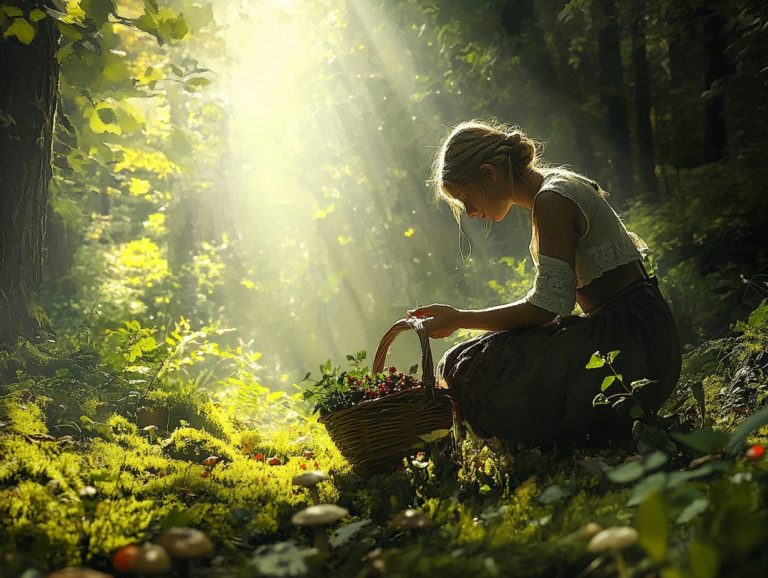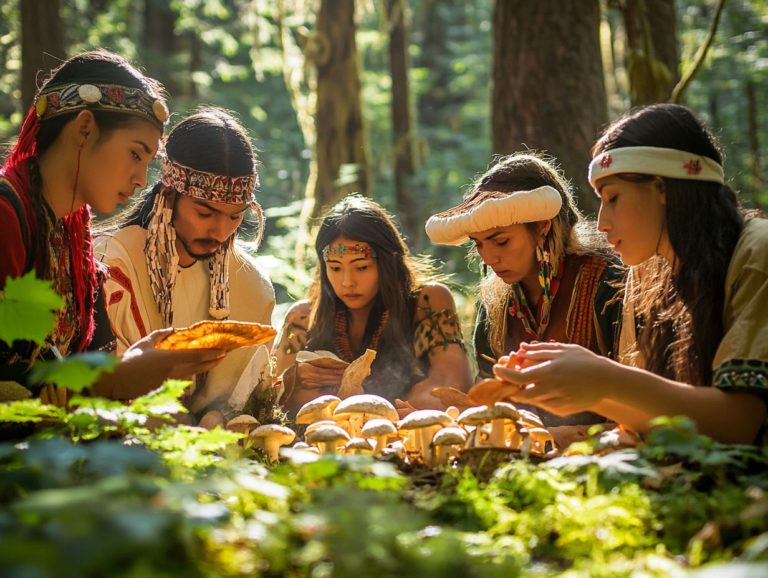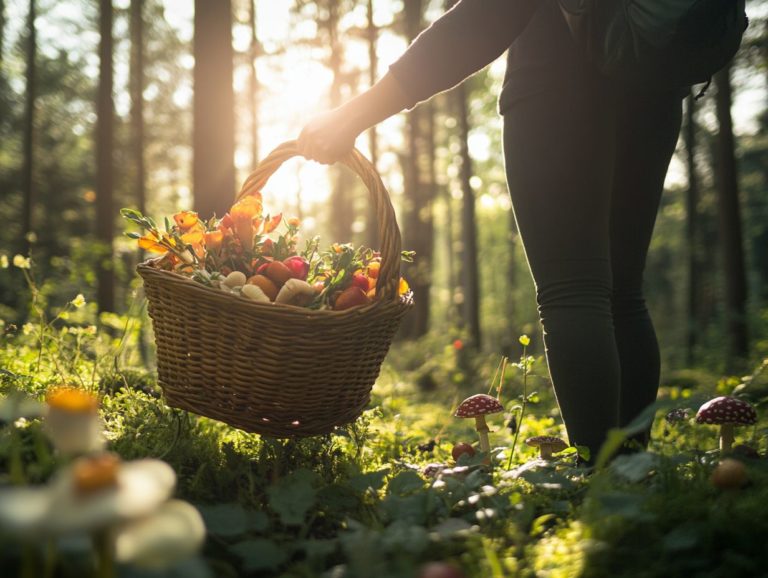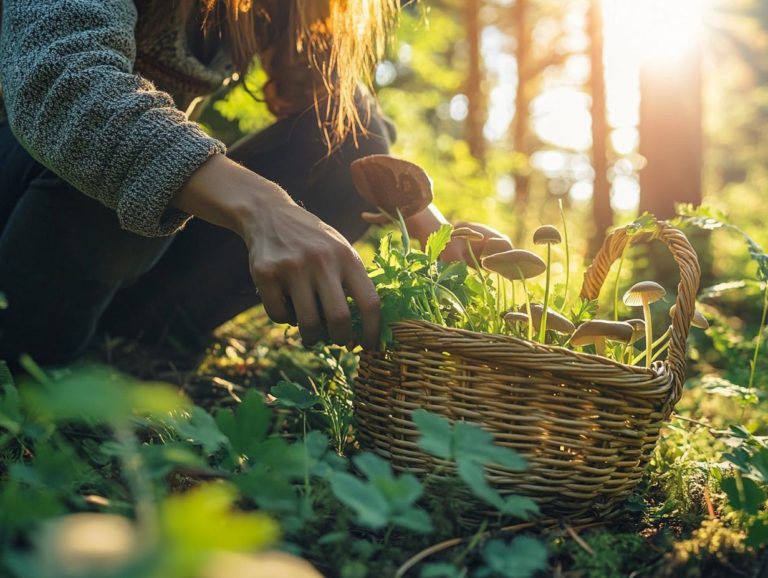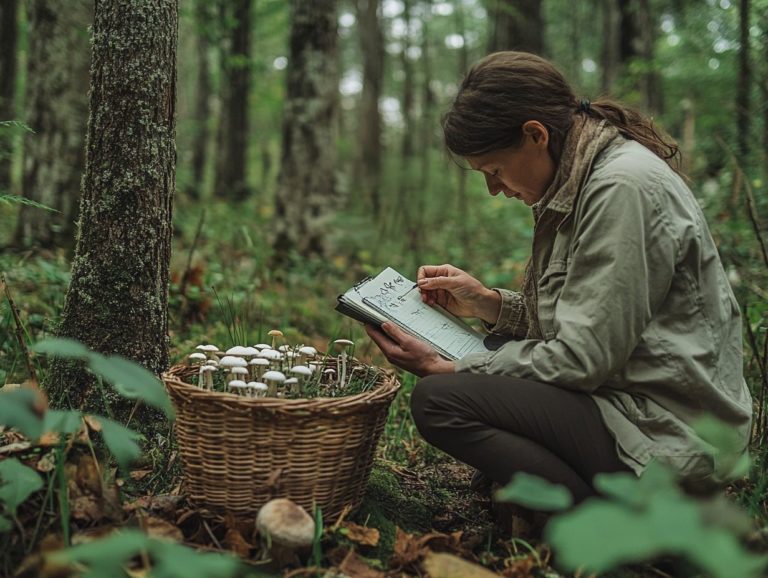Mastering the Art of Wild Foraging Techniques
Wild foraging is an ancient practice that allows you to reconnect with nature while uncovering a treasure trove of edible delights. This guide delves into what foraging truly means and its rich history, emphasizing the nutritional and environmental advantages it offers.
You ll find essential techniques for identifying edible plants and fungi, as well as the tools you’ll need to embark on your foraging adventure. Safety is paramount, so we’ll cover potential hazards and how to navigate them with confidence.
For those eager to elevate their foraging prowess, we ll also explore advanced techniques, including sourcing meat and seafood, as well as effective preservation methods.
Join us on this exciting journey to master wild foraging and enjoy nature’s bounty!
Contents
Key Takeaways:
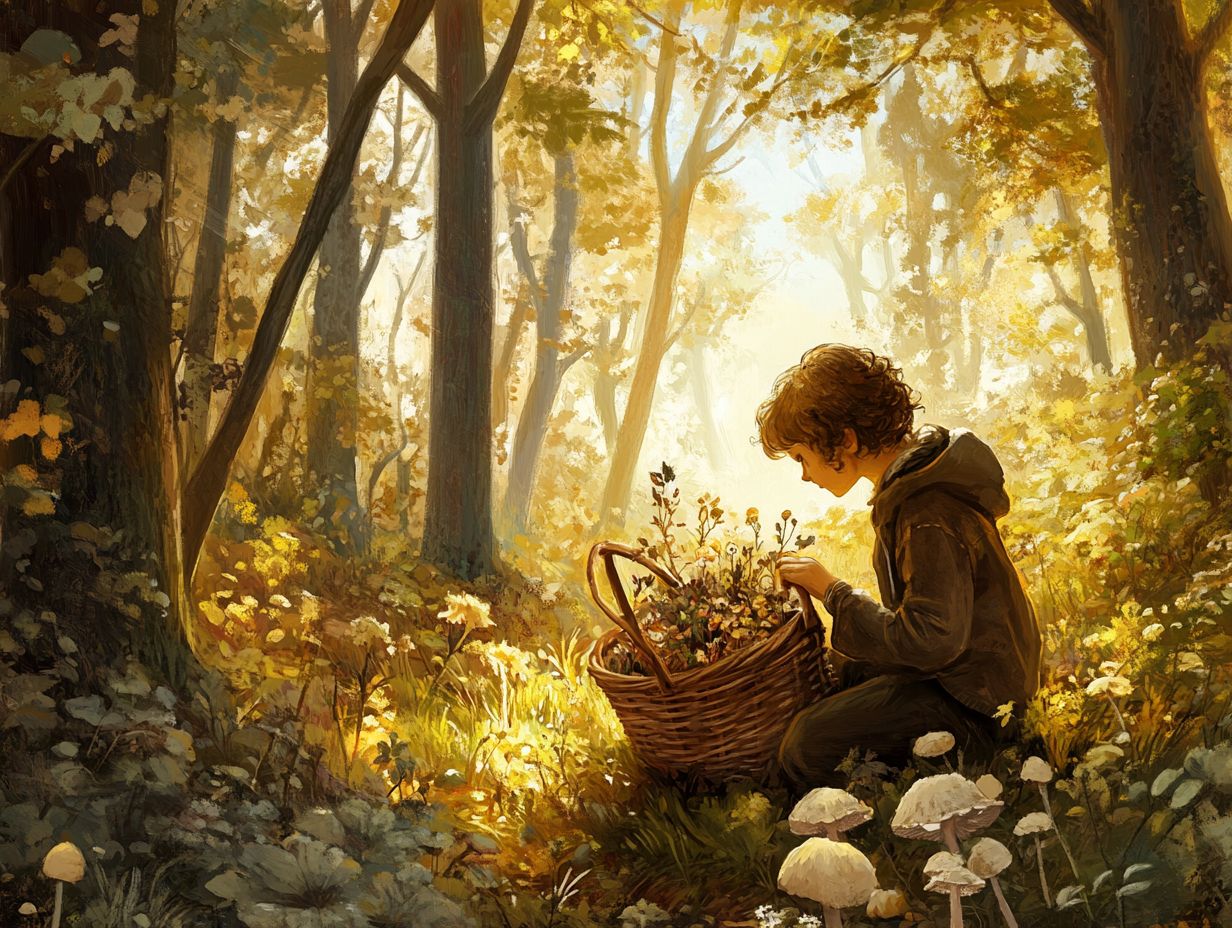
- Expand your knowledge and appreciation for nature by delving into the world of wild foraging. It has a rich history and offers many nutritional and environmental benefits.
- Master the basic foraging techniques of identifying edible plants and fungi, and choosing the right tools and equipment. These skills are essential for a successful and safe foraging experience.
- Forage safely by being aware of potential hazards and knowing how to avoid them. Take your foraging to the next level by learning advanced techniques for finding and preparing meat and seafood.
What is Wild Foraging?
Wild foraging is the art of harvesting edible plants, fungi, and other natural foods directly from the wild, a practice steeped in history and the essence of survival. In North America, this ancient practice is experiencing a renaissance thanks to authors like Douglas Boudreau and Mykel Hawke, who stress its significance in fighting against processed diets from big farming and consumer choices. For those looking to deepen their knowledge, a seasonal guide to the best foraging techniques can be invaluable.
As the population swells and the need for sustainable food sources intensifies, wild foraging is a fantastic way to live more self-sufficiently and appreciate nature, allowing you to reconnect with local native plants and the surrounding ecosystems.
Benefits of Wild Foraging
The benefits of wild foraging go well beyond the thrill of discovering wild foods; they offer substantial nutritional and environmental advantages that enhance sustainable food systems.
By incorporating edible wild plants into your diet, you can tackle health concerns linked to a meat-heavy and processed lifestyle while simultaneously supporting the conservation of local ecosystems.
This practice not only diminishes your dependence on consumerism but also inspires you to deepen your understanding of the natural world surrounding you.
Nutritional and Environmental Benefits
Edible wild plants present a remarkable array of nutritional benefits that can substantially elevate your health, especially when compared to a diet dominated by meat and processed foods. These wild foods not only deliver essential vitamins and minerals, but they also contribute to environmental stability by promoting the variety of plant and animal life in a particular habitat and mitigating the adverse effects of consumerism on local ecosystems.
Take bearded lichen, for instance. This extraordinary source of carbohydrates is highly valued by various indigenous communities, celebrated for both its nutritional and medicinal attributes. Similarly, taro shines with its abundant fiber, potassium, and essential vitamins, serving as a versatile staple in many cultures.
By foraging for these wild edibles, you gain access to nutrient-dense options while cultivating a deeper connection with the land. This practice enhances your ecological awareness and contributes to environmental health, ultimately building resilience against climate change through effective natural resource management and the sustenance of local ecosystems.
Basic Foraging Techniques
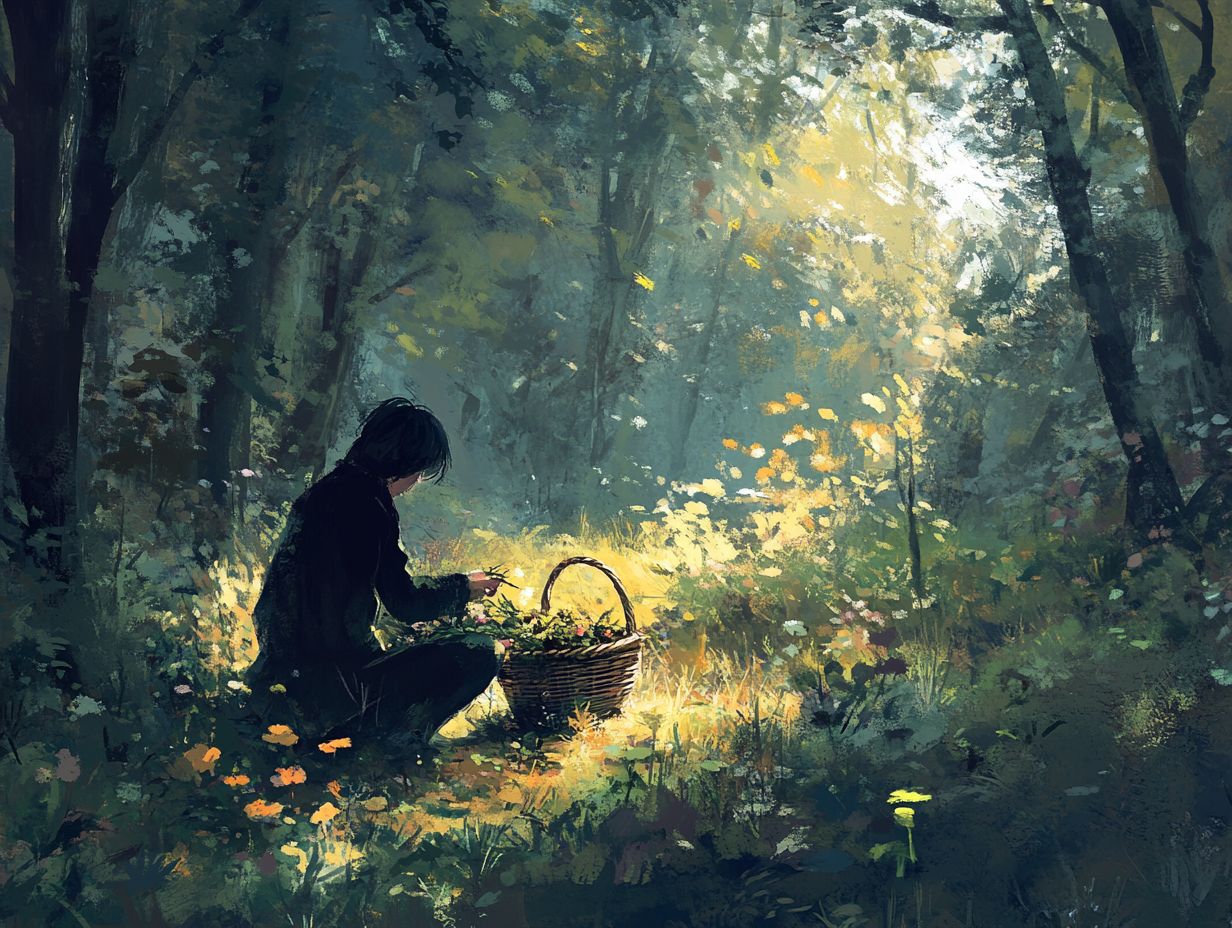
Unlock the thrill of wild foraging! Mastering basic techniques, as outlined in the art of foraging, opens the door to safely harvesting delicious wild foods, enabling you to identify edible plants while deepening your understanding of the surrounding environment.
From collecting insects and grubs to determining which plants are best left alone due to their ability to be harmful or poisonous, successful foraging hinges on both knowledge and skill.
By starting in your own backyard, you can embark on a journey of discovery. Uncover local edible plant species that flourish right in your vicinity!
Identifying Edible Plants and Fungi
Identifying edible plants and fungi is an essential skill for anyone venturing into the realm of wild foraging. It ensures your safety and allows you to fully appreciate nature’s bounty.
By understanding the characteristics of local native plants and recognizing the key features of edible varieties, you can steer clear of poisonous options. This makes your foraging experience safe and rewarding.
To navigate the world of wild edibles effectively, you should pay close attention to various visual characteristics. Leaf shape, color, and flower patterns can all indicate whether a plant is safe to consume.
Familiarizing yourself with the specific habitats where these desired plants thrive is invaluable. For instance, certain edible mushrooms flourish in damp, shaded areas, while others prefer dry, open fields.
Engaging with reliable resources, such as field guides or local foraging groups, can greatly enhance your knowledge. This support helps you confidently distinguish between edible and potentially harmful plants on your foraging adventures.
Foraging Tools and Equipment
Equipping yourself with the right foraging tools and equipment is crucial for a successful wild foods adventure. This enables you to gather and process your finds with finesse, enhancing your experience and embracing the joy of foraging.
Simple items like baskets, knives, and bags can significantly enhance your foraging experience. They allow you to explore your backyard or nearby wild spaces sustainably and with ease.
A sturdy basket for collecting edibles keeps your finds intact and promotes air circulation, helping to prolong their freshness. A well-designed foraging knife will enable you to safely harvest delicate plants and mushrooms without harming their environment.
Opting for reusable cloth bags is a sustainable choice for transporting your bounty, effectively eliminating the need for single-use plastic. When selecting these essential tools, prioritize durability and eco-friendliness.
Regular maintenance, such as cleaning and sharpening your knives, ensures they remain effective and safe for many years of foraging adventures.
Safety Considerations for Foraging
Safety considerations for foraging are of the utmost importance. The natural world is rife with potential hazards that can pose risks if not fully understood.
Your awareness of poisonous plants and your ability to identify warning signs are crucial for ensuring a safe foraging experience. This is especially important when gathering bugs and grubs or venturing into unfamiliar habitats.
Potential Hazards and How to Avoid Them
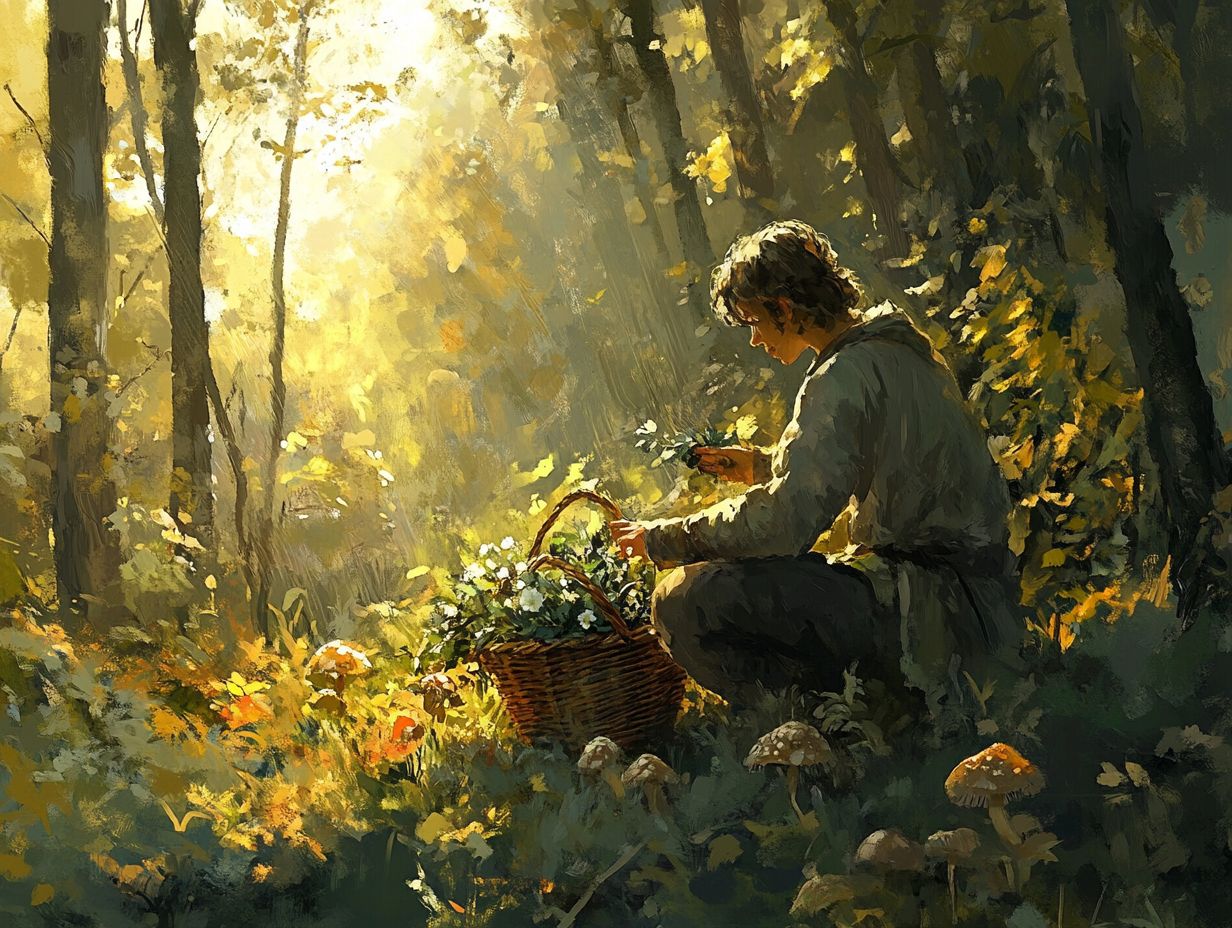
Understanding the potential hazards associated with foraging is crucial for ensuring both safety and success during your adventures. By being aware of risks such as consuming poisonous plants or encountering wildlife you can navigate the wild with confidence.
Learn to recognize warning signs and stay educated on local flora and fauna. This knowledge allows you to develop strategies that minimize hazards along the way.
Remain vigilant about the possibility of allergic reactions to certain edibles, which can vary significantly from person to person. Encounters with wildlife, like snakes or aggressive animals, can also present serious dangers while foraging.
Here are some tips to reduce risks:
- Go foraging with a knowledgeable partner.
- Carry a reliable field guide for identifying plants.
- Wear appropriate clothing and footwear to navigate through dense brush safely.
When trying new plants, always start with small samples to monitor for any potential adverse reactions. Armed with thorough knowledge and a cautious approach, you can confidently explore nature’s bounty while minimizing risks.
Advanced Foraging Techniques
Advanced foraging techniques unfold a world of exploration at your fingertips, enabling you to harvest a rich variety of plants, meats, and seafood from their natural habitats, while also connecting with nature.
By mastering these skills, you can not only diversify your diet but also elevate your cooking experiences, fostering a deeper connection with the ecosystems that surround you.
Foraging for Meat and Seafood
Foraging for meat and seafood requires advanced techniques that demand a deeper understanding of local ecosystems, sustainable practices, and ethical guidelines. Gather insects, shellfish, and hunt small game. This not only diversifies your diet but also deepens your respect for nature.
To truly excel in these endeavors, sharpen specific skills, such as identifying edible species and grasping hunting regulations. For those interested in foraging, exploring the art of seasonal foraging can provide valuable insights. When foraging for shellfish, be attuned to tidal patterns and adept at recognizing safe harvesting spots.
Hunting small game calls for proficiency with tools like traps or bows that are both effective and environmentally responsible. Incorporate practices that minimize impact on the environment; use only what you need and ensure local populations remain healthy and sustainable.
By respecting the land and its offerings, you engage in a cycle of renewal that benefits both you and the environment.
Preservation and Cooking Methods
Preservation and cooking methods are essential elements of your foraging journey, enabling you to savor the unique flavors of wild foods year-round. By mastering the best foraging techniques for families, you can not only extend the shelf life of your foraged treasures but also hone your culinary skills.
Dive into these methods and discover exciting possibilities! Imagine crafting sun-dried tomatoes from your foraged wild berries or transforming wild greens into tangy kimchi through fermentation.
Techniques like smoking or creating wild herb-infused oils can elevate flavors, adding a delightful twist to your cooking repertoire. You can also whip up flavorful syrups or chutneys, preserving your harvest while introducing diverse tastes to your dishes.
Recipes that feature wild mushrooms in risottos or nettle soup can elevate simple ingredients to gourmet status, showcasing the true beauty of nature s bounty. Grasping these preserving techniques allows you to carry the essence of foraging through the colder months, ensuring a lasting connection with the natural world.
Frequently Asked Questions
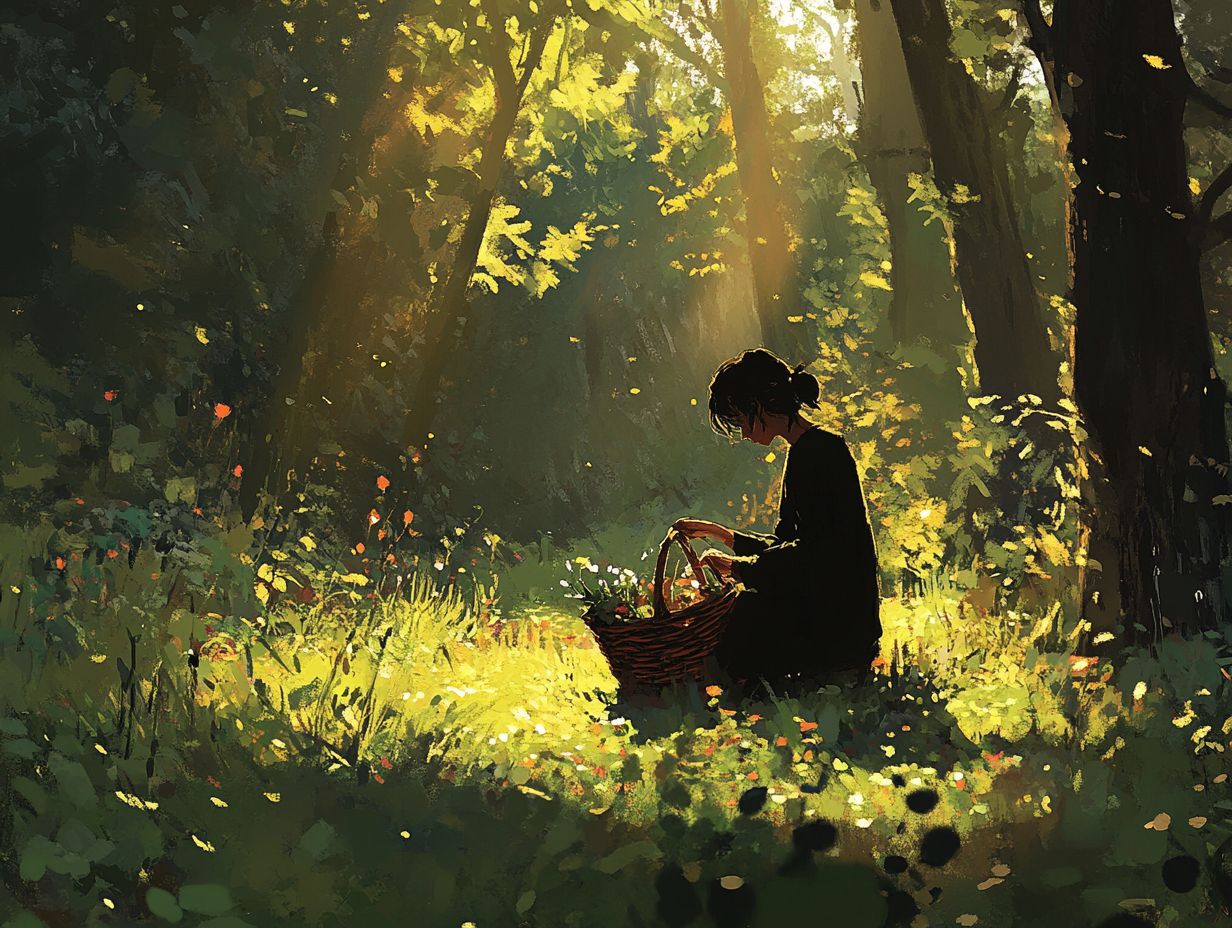
What is wild foraging and why is it important?
Wild foraging connects us to nature in a thrilling way! It involves gathering food from plants and animals found in their natural habitat.
This practice helps us learn about different species while providing a sustainable source of food.
What are some common tools used for wild foraging?
Common tools for wild foraging include a basket or bag for collecting food, a knife or scissors for harvesting, and a book that helps you identify plants and animals.
How do I know which plants are safe to forage?
Properly identifying plants before consuming them is essential. Use a trusted identification book or take a foraging class to learn about edible plants and how to avoid poisonous ones.
Can I forage for food in any season?
You can find plants and animals to forage year-round. However, the types and quantities of food may vary with the seasons.
What are some sustainable practices to follow when foraging?
When foraging sustainably, only harvest what you need. Leave some plants behind to help the ecosystem thrive and avoid overharvesting from the same area.
Always respect the environment and leave it as you found it.
How do I learn more about wild foraging techniques?
To learn more about wild foraging, attend workshops, join foraging groups, or read books and online resources. Exploring the growing popularity of foraging techniques can also be incredibly helpful, along with taking classes and gaining hands-on experience with experienced foragers.
Start your foraging journey today and discover the adventure of finding wild foods!

